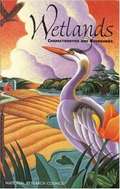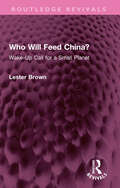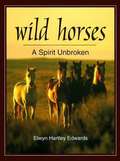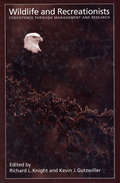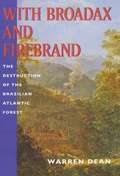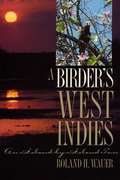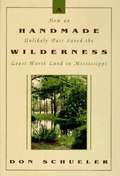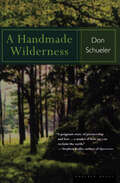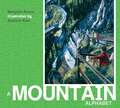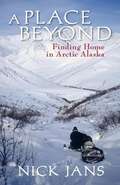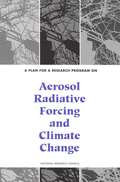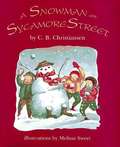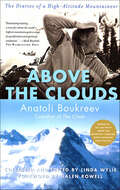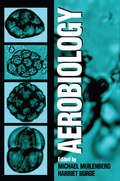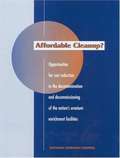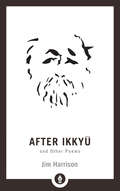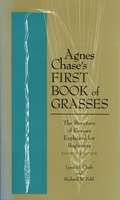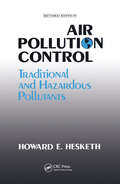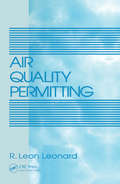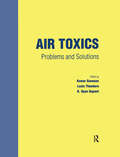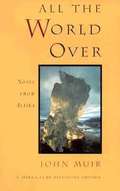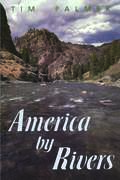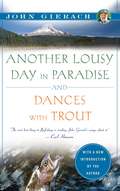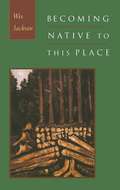- Table View
- List View
Wetlands: CHARACTERISTICS AND BOUNDARIES
by Committee on Characterization of WetlandsWetlands has become a hot word in the current environmental debate. But what does it signify? In 1991, proposed changes in the legal definities of wetlands stirred controversy and focused attention on the scientific and economic aspects of their management.This volume explores how to define wetlands. The committee--whose members were drawn from academia, government, business, and the environmental community--builds a rational, scientific basis for delineating wetlands in the landscape and offers recommendations for further action.Wetlands also discusses the diverse hydrological and ecological functions of wetlands, and makes recommendations concerning so-called controversial areas such as permafrost wetlands, riparian ecosystems, irregularly flooded sites, and agricultural wetlands. It presents criteria for identifying wetlands and explores the problems of applying those criteria when there are seasonal changes in water levels.This comprehensive and practical volume will be of interest to environmental scientists and advocates, hydrologists, policymakers, regulators, faculty, researchers, and students of environmental studies.
Who Will Feed China?: Wake-Up Call for a Small Planet (Routledge Revivals)
by Lester BrownOriginally published in 1995, but with enduring relevance in a time of global population growth and food insecurity, when it was first published, this book attracted much global attention, and criticism from Beijing. It argued that even as water becomes scarcer in a land where 80% of the grain crop is irrigated, as per-acre yield gains are erased by the loss of agricultural land to industrialization, and as food production stagnates, China still increases its population by the equivalent of a new Beijing each year. This book predicts that in an integrated world economy, China’s rising food prices will become the world’s rising food prices. China’s land scarcity will come everyone’s land scarcity and water scarcity in China will affect the entire world. China’s dependence on massive imports, like the collapse of the world’s fisheries, will be a wake-up call that we are colliding with the earth’s capacity to feed us. Over time, Janet Larsen argued, China’s leaders came to ‘acknowledge how Who Will Feed China? changed their thinking..’ As China’s wealth increases, so do the dietary demands of its population. The increasing middle classes demand more grain-intensive meat and farmed fish. The issue of who will feed China has not gone away.
Wild Horses: A Spirit Unbroken
by Elwyn Hartley EdwardsHorses are widely regarded as a favorite among domesticated animals. However, the twentieth century still harbors pockets of untamed horses and ponies whose evolution can be traced back over 60 million years. Wild horses exist in as diverse and hostile locations as the arid deserts of India and the remote sandbanks of Sable Island off the coast of Nova Scotia. Combine adaptability and an aggressive instinct for survival with exceptional stamina and sturdiness, and the resulting profile illustrates the divide between wild horses and domestic stock. Wild Horses traces the origins of today's feral equine species and explains how geographic history and crossbreeding have influenced their development and provided the variety of breeds which now exist worldwide. The wild horse inspires a range of differing responses. The rapid growth of the Australian wild horse population, the Brumby, led to thousands being killed for sport during the 1960s. This contrasts starkly with the treatment of the Kiang herds of the Himalayas, which are heralded as sacred by Tibetans. However, conservation efforts are now enabling many wild horses to survive and even flourish, encouraging a growing admiration and respect for their place in the natural world.
Wildlife and Recreationists: Coexistence Through Management And Research
by Joanna Burger Daniel J. Decker Richard L. Knight Kevin Gutzwiller H. Ken Cordell Paul KerlingerWildlife and Recreationists defines and clarifies the issues surrounding the conflict between outdoor recreation and the health and well-being of wildlife and ecosystems. Contributors to the volume consider both direct and indirect effects of widlife-recreationist interactions, including: *wildlife responses to disturbance, and the origins of these responses *how specific recreational activities affect diverse types of wildlife *the human dimensions of managing recreationists *the economic importance of outdoor recreation *how wildlife and recreationists might be able to coexist The book is a useful synthesis of what is known concerning wildlife and recreation. More important, it addresses both research needs and management options to minimize conflicts.
With Broadax and Firebrand: The Destruction of the Brazilian Atlantic Forest
by Warren DeanDean chronicles the chaotic path to what could be one of the greatest natural disasters of modern times: the disappearance of the Atlantic forest in Brazil.
A Birder's West Indies: An Island-by-Island Tour
by Roland H. WauerThe West Indies offer so much more than sun, sand, and shopping. This sweeping arc of islands, which runs from Cuba to Grenada and includes the Virgin Islands, teems with a rich diversity of plant and animal life. Up to 40 percent of the plants in some forests are found nowhere else on earth, while the West Indian flyway is a critical link in the migratory routes of many birds. In A Birder's West Indies, Roland Wauer takes you on an island-by-island journey of discovery. He describes the unique natural features of each island and recounts his often fascinating experiences in seeking out the nearly 400 species of birds known in the West Indies. His accounts give insight into the birds' habitats, status, and ecology and record some of the threats posed by human activities. For readers planning trips to the West Indies, Wauer also includes helpful, up-to-date facts about the best times to travel, the kinds of entry and customs systems to expect, the money exchange services available, and general information about weather, food, and accommodations. Filling a unique niche among current guides, A Birder's West Indies offers both professional ornithologists and avocational bird watchers a chance to compare notes and experiences with an expert observer. And for readers who haven't yet visited the islands, Wauer's fluid prose and lovely color photographs will be the next-best thing to being there-and an irresistible invitation to go.
A Handmade Wilderness
by Don SchuelerAs this book vividly narrates, in 1968, when Don Schueler and Willie Brown bought eighty acres in Mississippi, all they could afford was a piece of "least worst land." Moonshiners and poachers tried to scare them off, but Don and Willie stuck it out, restoring "The Place," bringing back the wildlife and plant life, until they had created a handmade wilderness containing every ecosystem found in the region.
A Handmade Wilderness: Untaming The Land
by Donald SchuelerA memoir of an interracial gay couple bringing eighty acres back to life in 1960s Southern Mississippi: &“This is no ordinary back-to-the-land book&” (Sue Hubbell). In 1968, when Don G. Schueler and Willie Brown bought eighty acres in Mississippi, all they could afford was a piece of &“least worst land&”—a parcel that had been logged, burned, and ravaged, about twenty-five miles from the Gulf Coast. Moonshiners and poachers tried to scare them off, but the two stuck it out, restoring &“The Place,&” bringing back the flora and fauna, until they had created a handmade wilderness containing every ecosystem found in the region. This is the true story of their amazing journey. &“Schueler and his partner purchased a bruised parcel of rural land, their goal to restore it to an ecologically balanced habitat for indigenous plant species and wildlife. Though his thoroughly engaging chronicle posits the dicey situation of a white man and a black man making a home in rural Mississippi in 1968, Schueler&’s account is replete with amusing anecdotes that illuminate a quarter-century of interactions with neighbors vastly different from themselves and the conscientious caretaking efforts they expended. The saga embraces hurricane Camille&’s destruction of a newly completed section of their house, and the fortitude that led them to build again, and the acquiring of a bevy of animals in the bargain.&” —Booklist
A Mountain Alphabet (ABC Our Country)
by Margriet RuursMountains are an impressive sight anywhere in the world but those of the western mountain region of North America offer riches that are truly unique. This lavishly illustrated picture book presents snowcapped peaks, emerald lakes, tall pines and magnificent maples, and a range of birds and animals that will fill readers of all ages with wonder.The treasures and mysteries of nature are depicted in twenty-six full-color paintings, each with a line of alliterative text. Objects that begin with that letter of the alphabet are waiting to be discovered in each illustration. Complete with detailed information about each setting painted, this is a visually and mentally stimulating experience – from A to Z.
A Place Beyond: Finding Home in Arctic Alaska
by Nick JansNick Jans leads us into his "found" home--the Eskimo village of Ambler, Alaska, and the vast wilderness around it. In his powerful essays, the rhythms of daily arctic life blend with high adventure--camping among the wolves, traveling with Inupiat hunters, witnessing the Kobuk River at spring breakup. The poignancy of a village funeral comes to life, hordes of mosquitoes whine against a tent, a grizzly stands etched against the snow--just a sampling of the images and events rendered in Jans' transparent, visual prose. Moments of humor are offset by haunting insights, and by thoughtful reflections on contemporary Inupiaq culture, making A Place Beyond a book to read and enjoy.
A Plan for a Research Program on Aerosol Radiative Forcing and Climate Change
by National Research Council StaffThis book recommends the initiation of an "integrated" research program to study the role of aerosols in the predicted global climate change. Current understanding suggest that, even now, aerosols, primarily from anthropogenic sources, may be reducing the rate of warming caused by greenhouse gas emissions. In addition to specific research recommendations, this book forcefully argues for two kinds of research program integration: integration of the individual laboratory, field, and theoretical research activities and an integrated management structure that involves all of the concerned federal agencies.
A Snowman On Sycamore Street
by C. B. ChristiansenThree children are having fun building a snow man in the snow. They also share Valentines and help one another. Good book for all ages. Delightful picture descriptions brings this story to life for blind readers. This file should make an excellent embossed braille copy.
A Walk Through The Heavens
by Wil Tirion Milton D. HeifetzA Walk through the Heavens is a guide to the pathways of the sky. It contains unique, simplified maps of the constellations and instructions on how to measure their sizes and the separations between them. Using this information you can find the constellations very easily and take a mind's eye journey from one constellation to its neighbours. The ancient myths and legends surrounding the constellations are retold, enriching our understanding of how historical peoples saw the awe-inspiring spectacle of a sky sprinkled with stars. Magically illustrated by Wil Tirion, this book does not assume that the reader has binoculars, and is ideal to inspire the young astronomer just starting out on a journey across the starlit skies.
Above the Clouds: The Diaries of a High-Altitude Mountaineer
by Anatoli BoukreevA breathtaking and lavishly illustrated autobiography in essays on Anatoli Boukreev, the late world-famous mountaineer and author of The Climb.When Anatoli Boukreev died on the slopes of Annapurna on Christmas day, 1997, the world lost one of the greatest adventurers of our time.In Above the Clouds, both the man and his incredible climbs on Mt. McKinley, K2, Makalu, Manaslu, and Everest-including his diary entries on the infamous 1996 disaster, written shortly after his return-are immortalized. There also are minute technical details about the skill of mountain climbing, as well as personal reflections on what life means to someone who risks it every day. Fully illustrated with gorgeous color photos, Above the Clouds is a unique and breathtaking look at the world from its most remote peaks.
Aerobiology
by Michael L. Muilenberg Harriet A. BurgeAerobiology is the study of airborne particles that have an impact on humans and other organisms. Every day, we are exposed to airborne particles, including "natural" particles such as pollen, bacteria, and fungi, and "unnatural" particles, such as asbestos fibers and noxious chemicals. Aerobiology highlights the current interests in this field, primarily the ecology and distribution of airborne particles and their effects on health.
Affordable Cleanup?: Opportunities for cost reduction in the decontamination and decommissioning of the nation's uranium enrichment facilities
by Committee on Decontamination Decommissioning of Uranium Enrichment FacilitiesThe Energy Policy Act of 1992 called on the National Academy of Sciences to conduct a study and provide recommendations for reducing the costs of decontaminating and decommissioning (D&D) the nation's uranium enrichment facilities located at Oak Ridge, Tennessee; Raducah, Kentucky; and Portsmouth, Ohio. This volume examines the existing plans and cost estimates for the D&D of these facilities, including such elements as technologies, planning and management, and identifies approaches that could reduce D&D costs. It also assesses options for disposition of the large quantities of depleted uranium hexafluoride that are stored at these sites.
After Ikkyu and Other Poems: And Other Poems
by Jim HarrisonA spirited collection of poems inspired by the Zen practice of one of America's most celebrated authors, Jim Harrison, a New York Times best-selling author.The popular novels of Jim Harrison (1937–2016) represent only part of his literary output—he was also widely acclaimed for the “renegade genius” of his powerful, expressive poems. After Ikkyū is the first collection of Harrison’s poetry directly inspired by his many years of Zen practice. The writing here is at once thought-provoking and passionate, immortalizing a celebrated American writer’s relationship to Zen in beautiful verse. These short, spirited poems will inspire you to look at life differently with a newfound sense of wonder and gratitude for everyday moments.
Agnes Chase#s First Book of Grasses: The Structure of Grasses Explained for Beginners, Fourth Edition
by Lynn G. Clark Richard W. PohlFor almost seventy-five years, Agnes Chase's First Book of Grasses has been the classic guide to the structure of this complex group of plants. Clearly written and copiously illustrated with line drawings, the book is accessible to those with little or no botanical training, yet it also is respected by botanists as an authoritative introduction to agrostology.Last updated in 1959, the book now has been thoroughly revised to reflect current scientific knowledge, nomenclature, and classification. Divided into twelve lessons, the guide first surveys the basic vegetative and reproductive parts of a grass plant, then in succeeding lessons takes up increasingly more complex modifications. Formally recognized groups of grasses are discussed in a taxonomic context, with the principal focus on grass structures, particularly those of inflorescences and spikelets. Virtually all of the species discussed are illustrated with detailed line drawings. With the addition in this edition of a lesson on bamboos, coverage now extends to tropical regions and encompasses all major groups of grasses. The book also includes a short biography of Agnes Chase in the foreword and, for the first time in this edition, a glossary accompanies the appendices on grass classification.
Air Pollution Control: Traditional Hazardous Pollutants, Revised Edition
by Howard D. HeskethSince the first edition was printed in 1991, there have only been minor changes in air regulations. The opposing "trenches" used by environmental regulation proponents have deepened as each side increases their database. Agencies and environmental groups have backed off a little in issues such as bubble policies and enforcement time tables. This has made it extremely difficult for equipment vendors to anticipate industry requirements. Overall, the current market projections are not very favorable for the new equipment suppliers. In contrast, the service organizations are seeing increasing need for their help in areas such as dispersion modeling, troubleshooting and testing. Existing systems are being improved upon to keep them in operation. There remains a continuous need for up-to-date references and training materials to serve these needs, and it is for this purpose this revised edition is dedicated.
Air Quality Permitting
by R. Leon LeonardThis practical book covers all of the fundamentals for obtaining air quality permits for new sources of air pollutant emissions and Title V operating permits for operating sources. Written for facility environmental managers, consultants, and air quality regulatory staff, Air Quality Permitting provides a thorough discussion on the strategies of successfully permitting a facility.
Air Toxics: Problems and Solutions
by Kumar GanesanThis timely new workbook is the result of a year-long effort by a group of university professors who first met at Montana Tech during the summer of 1994 for a college faculty workshop. The workshop was funded by the National Science Foundation's support for those faculty developing courses in the newly emerging field of air toxics. Part I of the book contains over 100 problems dealing with a variety of topics in this area. Part II provides detailed solutions. The problems and solutions provided will become a useful resource for the training of engineers and scientists who are or soon will be working in the field.
All the World Over: Notes From Alaska
by John MuirMuir explores into the vast and varied splendors of the natural world in Alaska.
America by Rivers
by Tim PalmerPhotographer and writer Tim Palmer has spent more than 25 years researching and experiencing life on the waterways of the American continent. He has travelled by canoe or raft on more than 300 different rivers, down wide placid streams and rough raging rapids. His journeys have taken him to every corner of the country, where he has witnessed and described the unique interaction of geographical, historical, and cultural forces that act upon our nation's vital arteries.America by Rivers represents the culmination of that grand adventure. Palmer describes the rivers of America in all their remaining glory and tarnished beauty, as he presents a comprehensive tour of the whole of America's river systems. Filled with important new information as well as data gathered from hundreds of published sources, America by Rivers covers: the network of American waterways and how they fit together to form river systems unique features of individual rivers along with their size, length, and biological importance environmental problems affecting the rivers of different regions and what is being done to protect and restore them cultural connections and conflicts surrounding the rivers of each region Chapters address the character of rivers in distinct regions of the country, and each chapter highlights one river with a detailed view from the water. Rivers profiled include the Penobscot, Potomac, Suwanee, Minnesota, Niobara, Salmon, Rio Grande, American, Rogue, and Sheenjek. Eighteen maps guide the reader across the country and 100 photos illustrate the splendor of Palmer's fascinating subject.America by Rivers provides a new way of seeing our country, one that embraces the entire landscape and offers fresh avenues to adventure. It is compelling reading for anyone concerned about the health of our land and the future of our waterways.
Another Lousy Day in Paradise (John Gierach's Fly-fishing Library)
by John GierachJohn Gierach invites fly fishermen and great writing aficionados to partake in this collection of witty, perceptive observations on fishing and life.
Becoming Native to this Place
by Wes JacksonFrom the book: "It has never been our national goal to become native to this place. It has never seemed necessary even to begin such a journey. And now, almost too late, we perceive its necessity. Unfortunately, the nature of the nativeness toward which we must work has been not merely altered but severely compromised. Part of the reason is that we have eight and a half times as many people in our country as we did when my grandfather was born. Perhaps even worse, the forces that have given us our modern problems--the ozone hole and global warming, acid rain, Three Mile Island and Chernobyl, soil erosion and loss of family farms, and so on--gain power by the decade. Destruction is occurring at an accelerating pace. It has all happened so fast (more than 80 percent of all the oil ever burned has been burned in my lifetime) [He was born 1936.] and it is going to get worse--half of Mexico's population is under fifteen years of age, ready for a major explosion. The world is slated to add one billion people in the 1990s alone. More people will be added in ten years than the total population of the earth at the time of Columbus. This book is dedicated to the idea that the majority of solutions to both global and local problems must take place at the level of the expanded tribe, what civilization calls community. In effect, we will be required to become native to our little places if we are to become native to this place, this continent"
